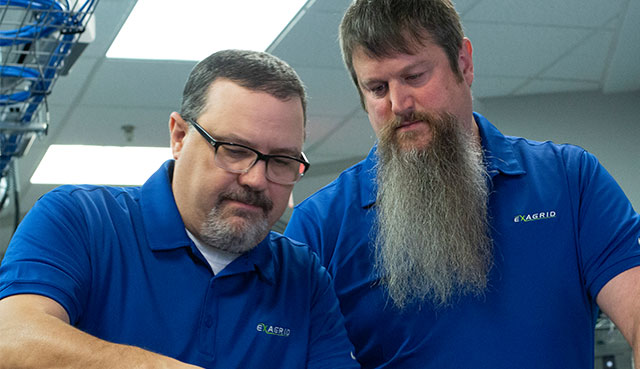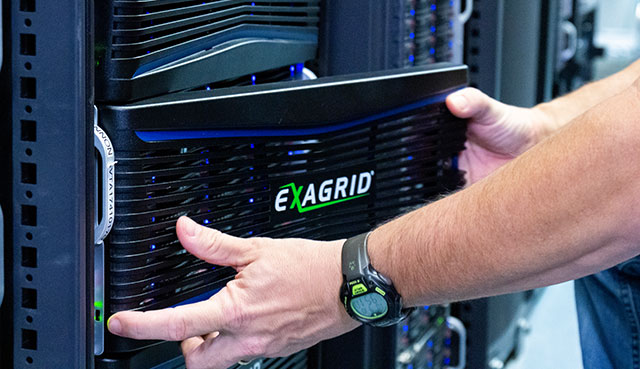NBU Accelerator, whether backups are incremental or full, moves only incremental changes from the clients to the media server. When using Accelerator for full backup, the latest changes are combined with the changed data from prior backups to synthesize a full backup. This accelerates the process of finding source changes and reduces the volume of data that is sent to the media server and backup storage, resulting in a shortened backup window. ExaGrid can take in and deduplicate NetBackup Accelerator data and, in addition, ExaGrid reconstitutes the accelerated backup into its disk-cache Landing Zone so that the ExaGrid system is ready to quickly restore data, as well as provide instant VM boots and fast offsite tape copies—a unique and exclusive feature.
Although NBU Accelerator shortens the backup window as with all technologies, there are some trades-offs detailed below.
First, NBU Accelerator does not create a traditional full backup. Instead, it creates only incremental backups forever. If any data in the chain of incrementals has been corrupted or is missing, the backups cannot be restored. Longer retention periods create longer chains of incrementals, and therefore introduce higher risk. Using NBU Accelerator to create a synthetic full does not mitigate the risk, as it is not a traditional full, but rather contains only pointers to previous incrementals.
Second, performing a restore of multiple incrementals can be time-consuming. To prevent this, it is recommended by Veritas that organizations using NBU Accelerator synthesize full backups on the backup storage, on a weekly or at least a monthly basis, to enable a restore of any daily, weekly, monthly, or yearly full backups. The trade-off of the shorter backup window is that while it does reduce the storage to a degree, it does not create a traditional full backup, which would allow for fast restores. NBU Accelerator only sends incremental changes and then uses pointers for all other operations, therefore, it can be very time-consuming to complete a restore, boot a VM, or make an offsite tape copy from any accelerated backup. This approach will not be as fast as keeping a traditional full backup.
The Challenges of Using NBU Accelerator with Inline Data Deduplication
Most backup appliances on the market utilize inline deduplication, which results in slow backup performance and lengthy restores.
Veritas NetBackup 5200/5300: The Veritas appliances struggle with ingest performance due to performing deduplication inline, which means the data is deduplicated on the way to the disk. It is an extremely compute-intensive process that slows down the backups. In addition, this approach to deduplication is not as granular as that of a dedicated deduplication appliance, and therefore requires more disk to store long-term retention resulting in higher storage costs.
Dell EMC Data Domain: Data Domain appliances have aggressive deduplication and use less disk, but are expensive due to the need for the front-end controllers to make up for the slow performance caused by inline deduplication.
In addition, inline deduplication only stores deduplicated data, making restores, VM boots, and offsite tape copies slow due to the time it takes to rehydrate the data for each request.
In either instance, backups are slow due to inline deduplication. In addition, restores are slow due the need to rehydrate deduplicated data for every request, and both are expensive.
ExaGrid’s Approach
ExaGrid’s unique approach is to first write backups directly to a disk-cache Landing Zone, avoiding inline processing and ensuring the highest possible backup performance, which results in the shortest backup window. ExaGrid’s Adaptive Deduplication performs deduplication and replication in parallel with backups while providing full system resources to the backups for the shortest backup window. Backups are then resynthesized into a complete full backup, which keeps the most recent backups as a true full backup in an undeduplicated form. This avoids the lengthy data rehydration process that is used by Veritas or Data Domain, resulting in restores that are up to 20 times faster.
- Fastest Ingest – Backups are written directly to the landing zone without the CPU load of deduplication. Once the data commits to disk, ExaGrid’s adaptive deduplication process deduplicates and replicates data in parallel with backups.
- Fastest Restores – ExaGrid is the only solution that stores the most recent NBU Accelerator full backup in its undeduplicated form to provide the fastest restores, VM boots, and offsite tape ExaGrid takes in the NBU Accelerator data in NBU format and then resynthesizes that data to create a fully- constituted backup in the Landing Zone. ExaGrid then retains longer-term retention in a deduplicated form in the ExaGrid repository. ExaGrid is the only backup storage with deduplication that maintains a fully hydrated copy in its Landing Zone for the fastest VM boots, restores and offsite tape copies.
- Maximized Storage – With the ExaGrid approach of maintaining a full backup copy in its disk-cache Landing Zone, the more backups that are kept (e.g., 8 weeklies, 24 monthlies, 7 yearlies), the more storage will be saved as ExaGrid is only keeping the changes from the synthesized full backups to the previous synthesized full backup, resulting in the lowest storage usage versus other approaches.
- Scale-out Architecture – ExaGrid’s scale- out architecture adds full appliances to a scale-out system adding all the necessary processor, memory and networking resources along with disk capacity. This approach maintains a fixed-length backup window as the data grows by adding the additional resources required for the ever increasing data deduplication overhead.
- Flexibility – The ExaGrid solution is flexible; as NBU Accelerator incrementals, NBU full backups, NBU database backups, as well as other backup application and utilities, such as, Veeam for VMWare, can simultaneously write into a single ExaGrid system. ExaGrid supports a wide range of backup scenarios and over 25 backup applications and utilities for a truly heterogeneous environment.
- Lowest Cost – The savings realized by ExaGrid customers can be as much as half that of competitive solutions due to ExaGrid’s aggressive adaptive deduplication and its low-cost architectural approach.
Data Sheets:
ExaGrid and Veritas NetBackup Accelerator



